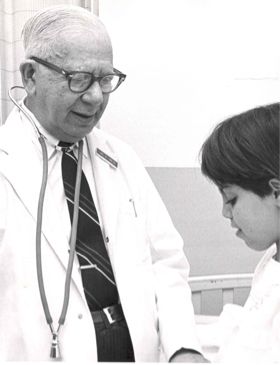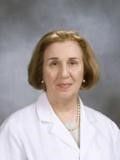
Carl Smith, M.D.
Photo courtesy of NewYork-Presbyterian/Weill Cornell Medical Center Archives
The first outpatient transfusion clinic in the country was established in the Division of Pediatric Hematology and Oncology at New York Hospital in 1944 by Dr. Carl H. Smith, one of the founding fathers of pediatric hematology and oncology. In the era before iron chelation therapy, individuals with transfusion-dependent thalassemia major lived only into young adulthood, eventually succumbing to iron induced heart failure. Successfully administered outpatient blood transfusions revolutionized treatment for chronically ill children who needed chronic transfusion therapy to sustain life. Prior to the opening of the transfusion clinic, thalassemia patients and others who required a blood transfusion had no other option than to be hospitalized, which meant time away from school and other routine activities. Dr. Smith’s transfusion experience contributed to the practice of liberal transfusion therapy in growing children to keep hemoglobin at a level to promote growth, and the use of packed red blood cells for transfusion therapy to decrease the number of transfusion reactions.
Along with Dr. Smith, a group of friends interested in the work being done in the field of blood diseases at that time created the Children’s Blood Foundation in 1952 to support training and research activities. The generosity of this foundation allowed for significant research findings, such as the benefit of splenectomy in reducing the number of transfusions required in the early 1950s. Dr. Smith was also the author of the classic textbook “Blood Diseases of Infancy in Childhood” - considered the standard text in pediatric hematology at the time.

Patricia Giardina, M.D.
The NewYork-Presbyterian/Weill Cornell Medicine Thalassemia Center entered a new era under the leadership of Dr. Patricia Giardina, its director from 1978 to 2013. Under her direction, the Thalassemia Program has played a significant role in the scientific advances and improved management of thalassemia, contributing widely to the increased understanding and management of thalassemia worldwide. She was one of the principal investigators in the Thalassemia Clinical Research Network, an NIH-sponsored consortium of the five major centers in North America. During this time, the Thalassemia Center pioneered several innovative therapeutic strategies including transfusion regimens, timing of splenectomy, iron chelation strategies to reduce iron-related morbidity, and bone marrow transplantation as a curative treatment. The research laboratories of Drs. Robert Grady and Stefano Rivella contributed greatly to our improved understanding of iron metabolism and hematopoiesis in thalassemia, and directed a more focused approach to iron chelation therapy. Improved management strategies developed within the program have transformed thalassemia major from an invariably fatal disorder to one manageable with intensive prevention and intervention strategies.
Today, the New York Comprehensive Thalassemia Center remains home to one of the largest thalassemia programs in the U.S., and is designated as a hemoglobinopathy specialty center by the New York State Department of Health. In keeping with Dr. Smith’s vision of expanding the possibilities of care and seeking what is best for patients, our center has grown to become an ideal comprehensive medical home, providing onsite screening, diagnosis, counseling, treatment and support services from a multidisciplinary team at the cutting-edge academic medical institution that is NewYork-Presbyterian/Weill Cornell Medicine. Thalassemia, which was once a fatal childhood disease, is now a condition with patients living well into adulthood with a near-normal quality of life, going to school, pursuing careers, having families and leading productive lives.

